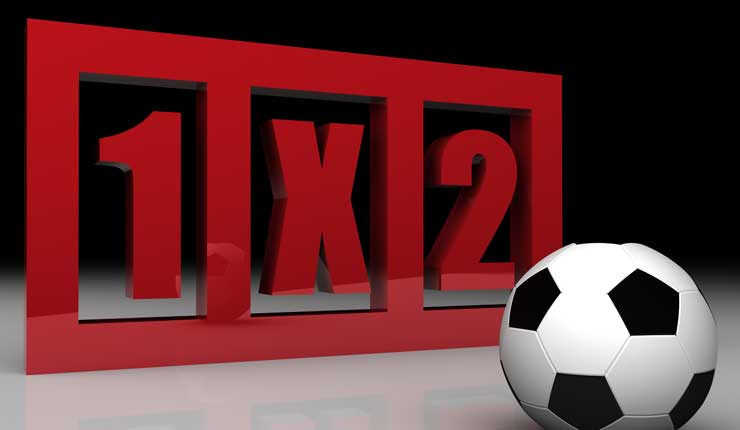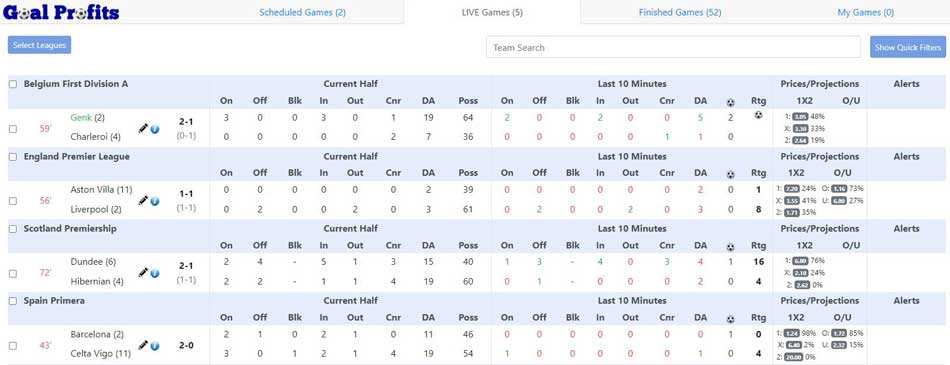Lay the draw (often abbreviated to 'LTD') is still one of the most popular football laying strategies on betting exchanges.
For many years lay the draw was probably the best football trading strategy you could find, but has recently faced a few problems due to its growth in popularity.
Lay trading can be the best way to make money on a betting exchange, such as Betfair or Matchbook. However, you must be patient enough to wait for the right opportunities.
A disciplined football trader will resist the temptation to get involved with whatever matches happen to be on the fixture list and only put his or her money at risk when it makes sense to do so.
In this article, I will explain the traditional method of laying the draw and why it is not as effective as it once was. I will then show you how you can still use this evergreen football trading system to grow your betting exchange balance month after month.
How does Laying the Draw Work?
Lay the draw (or "LTD") strategies involve placing a lay bet on the draw.
Once the favourite scores a goal, the draw price will rise and you will be able to close out your trade for a profit. If the match ends in a draw, your trade will lose.
At a traditional bookmaker you're able to back various outcomes, perhaps a home win or over 2.5 goals.
However, a betting exchange such as Betfair, Smarkets and Matchbook also offer you the opportunity to go the opposite way and place lay bets on these outcomes.
For example, you could lay the home win and then you make a profit if the football match ends with the home team failing to win the match, i.e. if the match ends in a draw or away win.
In just the same way, with a lay the draw strategy you are looking for matches that are not likely to end in a draw.
You can lay the draw at a betting exchange and if the final score is 1-0, 3-1, 0-2 - anything but a draw - you win the bet.
Almost every football trader starts with a lay the draw system as it's so easy to understand and use.
There's a big difference between betting and trading though, so let's start with that.

Lay the Draw Betting
Let's imagine that Manchester United are at home to Arsenal and you think that the match is most likely to end in a home win.
When you log in to your favourite bookmaker account, you see lots of pre-match options to back the home win, back Manchester United to 'win to nil' or even back Manchester United to win by more than one goal.
However, you really need your chosen team to perform otherwise you're not going to win your bet.
Your other option is to log in to a betting exchange instead.
The Match Odds market will give you the same options to back the home win, away win and draw but you will also be able to lay any of them.
You could back Manchester United exactly the same as at a bookmaker, but you're still relying on them to perform.

You could lay Arsenal so that as soon as the match kicks-off you're already winning your bet, but an away win would be an expensive loss.

Laying the draw is somewhere in between and, as long as one of teams gets a positive result, you will end up with a profit.
For example, if a Manchester United player is sent off early in the game and Arsenal go on to win, your lay bet still wins.

So that's back and lay betting covered and now we can look at how trading lay the draw is different from betting.
Lay the Draw Trading
With betting, a 1-1 result when laying the draw will always result in a loss.
However, if you are prepared to trade while matches are in-play, then you may still be able to bank a profit.
This is because of price movement and the effect of goals on Match Odds market prices.
Continuing with the example of Manchester United v Arsenal, the home side scored a goal during the first half and this caused market prices to change.
The favourites were 1-0 up and even more likely to win the game than they were when the score was 0-0, so the home win price fell and the away win price soared.
Applying that same logic to the draw, it was also less likely to happen than it was when the score was 0-0 so that price rose as well.
This price movement meant it was now possible to lock in a profit.

The calculation is easy with our free Hedging Calculator.
Say you had layed the draw at kick-off at 4.80 with a £100 stake
You would now be able to back the draw at that higher price for less of a stake and the difference would be your profit.
In this example, our lay the draw calculator shows that a back stake of £61.54 results in £36.54 profit.
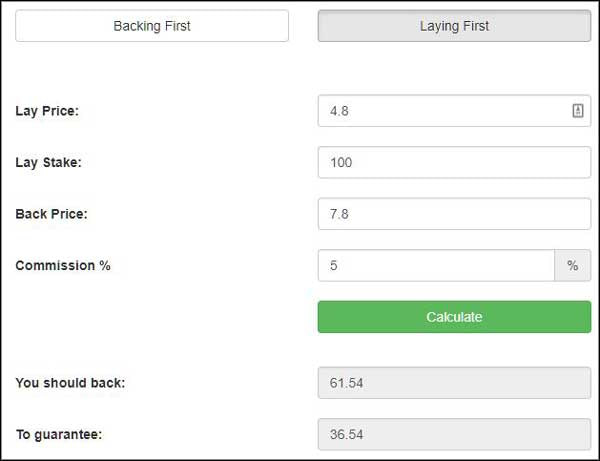
That's £36.54 profit on every outcome; home win, away win or draw.
Your trade is complete and you can let the rest of the match play out safe in the knowledge that your profit will be added to your Betfair balance once the match ends.
It's not much less than the profit had you backed Manchester United at 1.50 and left the bet to run, risking an Arsenal equaliser.
There are other options too. If you back the draw for just enough to cover the liability, you will now have a free bet on the home win with the score already 1-0.
Because you don't need to back the draw as much, you will have more profit left over.
That's even closer to the profit of a straight bet on the home win and there's no longer any risk.
You could even sit back and do nothing. If Manchester United go 2-0 up then the draw price will rise a lot higher and you'll be able to lock in much more profit.
In this particular game, Arsenal equalised soon into the second half. As you can see below, the market reverted to a similar state as it was pre-match.
Manchester United were still favourites to win and Arsenal were underdogs, but the draw price was now much lower.
Because there was less time to be played (40 minutes) the draw was more likely to happen and, therefore, the price fell accordingly.

Once 80 minutes had been played and the score was still 1-1, the draw was now the firm favourite.
Although Manchester United were attacking constantly, the Arsenal defence was holding firm and you can see below that the draw was odds-on at the betting exchange.
In other words, every £1 layed resulted in less than £1 liability. This is very attractive to layers, but time was running out fast.

In the end, Manchester United found a winner on 90+1'.
- If you had layed the draw as a set-and-forget bet pre-match then you would have made a profit, but you would have had a rather uncomfortable second half!
- If you'd traded out for a profit at 1-0 then you would have had a much more relaxing afternoon.
- Had you layed the draw at 1-1 late on when it was much cheaper, your return on investment (ROI) would have been extremely high.
Football trading is wonderfully flexible and there are many ways to make a profit.
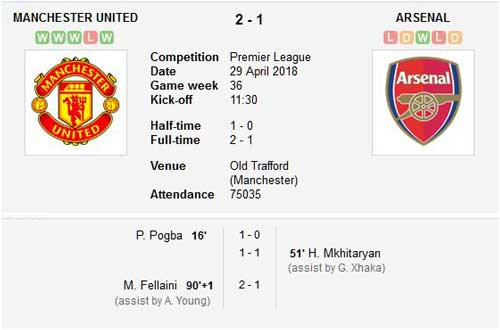
Lay the Draw Exit Strategies
It's all well and good when things go to plan, but football is full of surprise results so it's important to have plans in place for when matches don't go as expected.
The main lay the draw exit strategy is for when a match is still level (perhaps 0-0 or 1-1) and time is running out.
Rather than risk a full loss (£380 in our Manchester United v Arsenal example) you can choose to accept a much lower managed loss.
Most matches that are level see the draw price reach 2.00 around the 65 minute mark.
If the teams are evenly matched or there's not much action in the game it will be sooner, but if there's a strong favourite - particularly one dominating the game and attacking hard - it will take a little longer.
Rather than risk the match ending in a draw, you can choose to accept a smaller loss and move on to your next trade.
You do this by backing the draw at 2.00 in order to leave an equal loss on all outcomes.
As you can see below, the Manchester United v Arsenal draw price was still above 2.00 at 69' but it was getting close.

Our Hedge Calculator shows that at Manchester United you would back the draw at 2.00 for £240 and that would leave £140 loss on all outcomes.

Again, when you compare this with a straight bet of £100 on the home win it's not much different, just that you need to get out of the trade earlier.
If one of the teams goes on to score later in the match, it's no good to you.
You could choose to stay in and risk the larger loss, but you have to bear in mind how many winning trades you would then need just to get back level.
That would be a lot of extra work for no profit.
Of course, you could lay the draw once more later in the game when the liability is much less and, perhaps, recover some (or all) of your loss.
For this to be a wise move, you need to be certain that at least one of the teams is desperate to win the game and will do all they can to score a late goal.
If not, you're better off leaving it alone and moving on to your next trade.
Our Live Stats Module tracks every game in-play and shows you exactly which teams are trying to score. It's a great addition to your toolbox.
When the Underdog Scores First
Here's another situation that crops up a lot.
When an underdog scores early against a strong favourite (particularly away from home) you will be in a loss position, even though you're technically winning the trade!
You have layed the draw and the score is no longer level, but the market will assume that the favourites are likely to equalise.
Therefore, the draw price will not rise enough to trade out for anything more than a loss.
In this situation, you have a decision to make:
- Trade out for a managed loss and, perhaps, lay the draw again if the favourites equalise with enough time left to find a winning goal.
- Stay in the trade and hope that the underdog stays ahead long enough for the draw price to rise so that you can trade out with scratch. They may even score again and that would be enough to trade out immediately for a profit.
- Use the Metaltone strategy, which banks on the favourites equalising.
Metaltone is a lay the draw exit strategy for when an underdog goes ahead against a strong favourite.
Rumour is that Metaltone originated on the Betfair forum and that it was the username of the original poster, but no-one seems to know for sure.
Here's how it works.
Let's say there's a home favourite and the score goes 0-1. With Metaltone you then:
- Back the draw with 50% of your liability
- Lay the underdog with 75% of your liability
The idea behind this is that the favourites will equalise at some point.
This will push the price on the away win a lot higher and you'll be able to trade from there; either locking in a profit or going back to a lay the draw trade.
That's all well and good, but if time ticks by and the score remains 0-1 you'll have been edging closer to a profit by doing nothing.
And if the score were to go 0-2 (or the favourites pick up a red card) you'd have been in profit by sitting on your hands, whereas with Metaltone you'd be in the red.
So... should you use the Metaltone strategy or not?
My advice is use it now and again, rather than as your standard lay the draw strategy.
If the favourites are in good scoring form and the in-play stats show that they're on top, it can be a very effective way of getting out of trouble.
As always, be flexible with your trading and take each individual trade on its own merits. Sometimes it's better just to take the smaller loss and live to fight another day.

Lay the Draw with Insurance
There are a number of ways to add some insurance to your trades.
Some traders like to back 0-0 so there's no risk of loss should a match end with no goals.
The price is typically in double figures at kick-off, but any goal scored immediately renders the insurance useless and then it's wasted money.
It's well worth getting to know the leagues you plan to trade before you put your money at risk.
For example, our Team Stats Database shows us that approximately 8% of all football matches played around the world end 0-0.
During the whole of 2023, only 3.4% of English Premier League matches ended 0-0 but 10.8% of Spanish Segunda fixtures finished goalless.
That's a big difference!
Considering so few matches end 0-0 in many leagues, you have to be careful when thinking about insurance as most of the time it will lower your profit margin.
Another ploy has been to back 1-1 so that there's plenty of cover once a team scores.
The betting exchange price is often in single figures though and it doesn't help when the score is 0-0... or 2-0 and beyond.
While laying the draw with insurance may be attractive to you, I found that it simply reduced my profit for winning trades.
Rather than try to mitigate trades that go wrong, I put more effort into trade research so that I get caught out less often.
Of course, that's just my personal choice and you need to do whatever works for your own trading style.
Many new traders come from a matched betting background and are not used to accepting losses.
It may make trading a bit more comfortable at first, so if insurance gives you peace of mind then it's an option to consider.

Is it Still Worth Trading LTD?
With lay the draw being such a great strategy it became very popular.
At one point, almost every Betfair trader was using LTD in one form or another which brought about a big problem.
As any economist will tell you, there’s such a thing called supply and demand and we can apply it to betting exchange markets.
If a greater number of football traders want to lay the draw, the draw price will rise as the money in the markets is sucked up.
Sure, liquidity may increase but there is always a limit – especially in smaller leagues.
Once the favourites score, the draw price rises as normal and all those extra traders now want to back the draw in order to lock in their profit.
The first few may get matched at 8.00, for example, then that liquidity runs out.
More traders are matched at 7.80, then 7.60, then a few think it’s best to be safe so are happy to get matched at 7.40.
At some point it actually becomes value to lay the draw again, but that’s a discussion for another time.
In short, more lay the draw traders means laying at a higher price and backing out again at a lower price. That leads to a smaller profit margin.
The real kicker comes when there’s a loss – and they happen from time to time, we all know that.
A loss is not going to get any cheaper and, if laying the draw at a higher price, will in fact get larger.
It used to be possible to cover a loss with 2-3 profitable trades and get back on track quite quickly, but these days it may take up to 5 games if favourites only get to 1-0.
So, as lay the draw became more popular, traders enjoyed smaller profits and suffered larger losses. Not good!
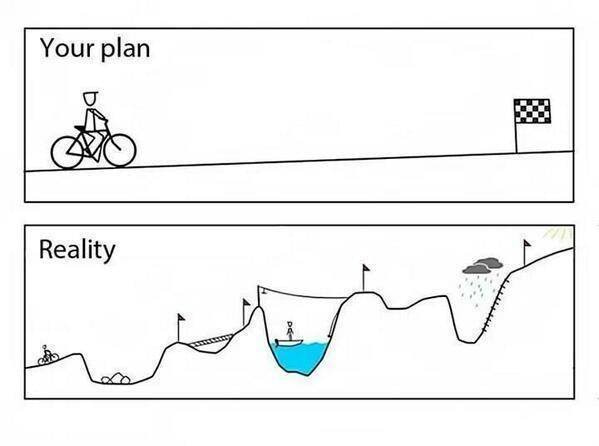
So... Is Lay the Draw Dead or Not?
As Betfair markets evolve, we must make changes to our trading strategies.
Betfair markets are always changing and traders have to move with them or fail.
This is why Kevin Laverick and I are forever updating Goal Profits strategies for members and developing new trading systems.
In the Goal Profits Members Area we are able to update or switch out systems which have lost their edge, ensuring that members always have an advantage over everyone else trading on the betting exchanges.
When I first starting trading football on Betfair I thought it was as easy as buying a few profitable systems and then sitting in front of my computer screen to start lining my pockets.
Unfortunately, I quickly realised that's not how it works in the real world and, thankfully, everyone else has too.
For example, you see a lot fewer eBooks on sale these days which promise that you can make money on Betfair for just "five minutes work".
Think about it... if Betfair trading was so easy then you wouldn't go to work on Monday morning, you'd be trading football!
But anyway, back to lay the draw.
As profit margins declined from the traditional LTD method, many football traders declared it was all over – that lay the draw was dead.
What a load of rubbish!
You don’t quit because it’s getting more difficult, you find a way to make it work again.
You adjust the way you select matches and the way you trade them. You think out of the box, whatever it takes to get the risk/reward back in your favour.
Quitters drive me crazy!
Yes, absolutely it's still worth trading LTD but you need to get smarter.

How to Trade Lay the Draw Today
The biggest change that I have made to my own LTD trading is that I no longer trade the entire 90 minutes of any match.
These days, I employ a couple of lay the draw strategies in either the first or second half.
Apart from the fact that it halves the time needed to trade, splitting my trades in this way reduces liability and increases potential profit.
The downside (there's always one!) is that there's less time to find a goal. However, the benefits far outweigh that.
The Team Stats software available to Goal Profits members makes trade selection a breeze and it even generates a couple of shortlists each day for new traders to follow.
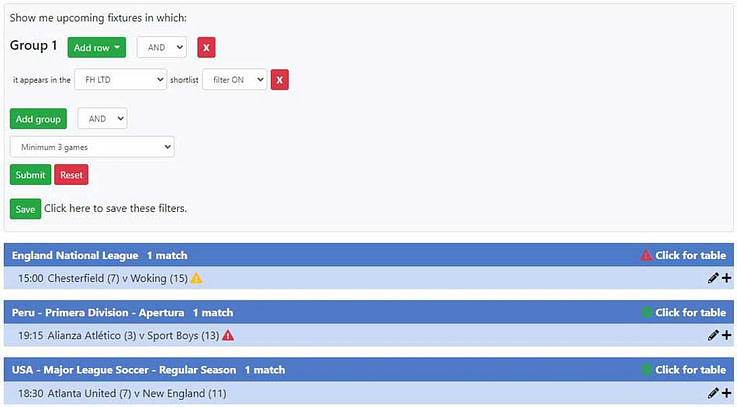
Of course, you also can create your own filters based on hundreds of different data points and then Team Stats will do all the hard work for you each day.
Click here to read more about Goal Profits membership.
First Half Lay the Draw
First half lay the draw is tricky, since no team ever has to score before half-time.
On the flip-side, the prices are much more favourable so get it right and first half LTD is extremely profitable.
In the Manchester United v Arsenal match you can see it was a lot cheaper to lay the half-time draw and, with the half-time score 1-0, it was a winner too!

Our Team Stats Database shows that the average game of football has 1.15 first half goals and that less than a third of all matches played are 0-0 at half-time.
During 2023, only 26.9% of English Premier League matches had no first half goals.
As before, Spanish Segunda teams were not as effective at scoring goals, but still only 36.6% of their games were scoreless at the break.
It doesn't seem a particularly tall order to find a goal in the first half and the cheaper draw price means less liability too.
Once a goal is scored, there's not as long left for the opposing team to find an equaliser and they don't have to either as they still have 45 minutes after half-time to do it.
This results in the draw price rising much more and very healthy profit margins.
Despite all that good news though, match selection is still a challenge.
Once 20 minutes have been played, the draw price is often already at 2.00 to lay so anything above a 50% strike rate will result in a long-term profit.
The problem is that many matches will have already had a goal scored so won't be tradeable, while all those which are going to reach half-time at 0-0 will be.
It's not as simple as picking out very strong favourites either.
The best teams in the world - Barcelona, Bayern, Man City, etc - are patient and their opponents will often have a gameplan to get to half-time without conceding a goal.
As usual, prices are higher for 'elite' teams so that's another good reason to avoid them.
My ideal match selection for first half lay the draw is a fairly good home favourite playing a decent away team who are capable of scoring and will play the game.
Having both teams try to score is far better than just one!
Second Half Lay the Draw
If the half-time score is level, there's an opportunity to lay the draw in the second half.
There's not a dedicated Betfair market for this like there is for the first half as you use the main Match Odds market.
Although Manchester United v Arsenal was not level at half-time, it was 1-1 soon after.
You can see below the sort of discount in the draw price you will enjoy when waiting until the second half.

Rather than laying at the start of the match at 4.80 (which would have created a liability of £380) you could have waited until the 50 minute mark.
Laying at 2.90 would have created exactly half the liability (£190).
The greater benefit of this discounted draw price is that the profit margin is improved.
For example, if you lay the draw at 4.80 with a stake of £100 and then trade out with the score 1-0 at 7.80 - as we looked at before - your profit is £36.54.
However, waiting until the second half and laying at 2.90 increases that profit to £59.68.
And that's assuming that the draw price only rises to 7.80. In this situation, it's likely to go a bit higher as Arsenal have less time to find an equalising goal.

Another plus point for second half lay the draw is that if the underdog goes ahead, the draw price will be above your original lay price so you will still make a profit.
While it won't be as much of a return, it's reassuring to know that a goal either way is going to make you some money.
When trading in the second half, you need to be sure that at least one of the teams is trying to win the game.
Our Live Stats Module tracks all the action in hundreds of games every week and even shows you when teams make attacking substitutions.

You can usually bank on home favourites to play to win until the final whistle, but some away teams will see a draw as a satisfactory result and play more defensively than you need them to.
Although you will miss some trades when goals are scored early in the second half, it often makes sense to wait for the draw price to fall before laying.
The lower you lay at, the lower the liability and greater potential return for your risk.
You will also be able to judge from the number of shots and corners how each team has started the second half.
If the favourites are not attacking strongly, why do you want to be in the trade anyway?
In Summary
Lay the draw trading has been around for almost as long as Betfair and it will not be going anywhere soon, no matter what the doom and gloom merchants try to tell you.
In fact, the more who declare that LTD is done with, the better.
That means fewer traders fighting over the same prices and more profits for us!
As the old saying goes, "quitters never win and winners never quit".
Before you go diving in, remember that patience is often rewarded.

I only need 2-3 strong trades on a busy day to contribute to and hit my monthly target.
I can afford to be extremely patient, wait for fantastic trading opportunities to come along and then take full advantage.
Avoiding a loss is even better than a win so my focus is completely opposite to many traders - and it works!
If you really want to make money from football trading, you have to treat each trade as an investment.
If it's a bit of entertainment for a Saturday afternoon you'll have some fun, but long-term - and potentially life-changing - profits will be difficult to achieve.
